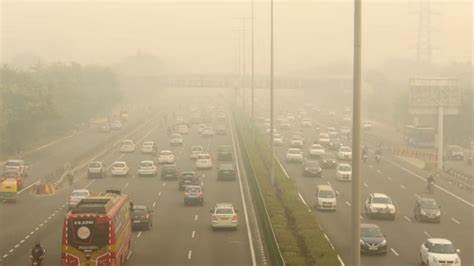Air quality in Delhi will fluctuate in the coming days: Environment minister Gopal Rai

Air quality in Delhi will fluctuate in the coming days: Environment minister Gopal Rai
Delhi’s environment minister, Gopal Rai, has highlighted concerns about fluctuations in the Air Quality Index (AQI) in the national capital in the coming days, especially with the onset of the festive and winter seasons. The AQI in Delhi has been a subject of significant concern, often reaching hazardous levels during the winter months.
Rai’s observation that the AQI has recently decreased and fallen below 300 is a positive development, indicating temporary respite from severe air pollution. However, he anticipates that these levels will continue to fluctuate, and there is a likelihood of the AQI rising again after October 30.
Delhi’s air quality is a complex issue influenced by various factors, including weather conditions, stubble burning, and increased vehicular emissions. The government and authorities need to take sustained measures to mitigate air pollution and improve air quality, particularly during the winter months, to safeguard public health and the environment.
The improvement in Delhi’s air quality, with the Air Quality Index (AQI) recorded in the ‘moderate’ category at 190 on Wednesday, as reported by SAFAR-India, is a positive development for the national capital. This indicates a temporary relief from the heightened pollution levels that were prevalent earlier. It is noteworthy that the AQI had crossed 300 in multiple pollution hotspots in Delhi on the preceding day.

However, despite the improved air quality, instances of firecracker burning were reported from various parts of Delhi during the Dussehra festivities. Given this, the environment minister has urged neighboring states to enforce a ban on firecrackers during the upcoming Diwali celebrations.
This proactive approach by the minister underscores the critical need for collaborative efforts and stringent measures to maintain the improved air quality and mitigate the potential hazards associated with festive celebrations, particularly during the winter season when pollution levels tend to escalate. Such initiatives play a crucial role in safeguarding public health and promoting environmental sustainability.

The observation by the Delhi environment minister, Gopal Rai, regarding a relatively lesser number of locations where firecrackers were burst during the Dussehra festivities highlights a potential positive trend in the city’s efforts to curb air pollution during celebratory occasions. His call for neighboring states within the Delhi-NCR region to also enforce a ban on firecrackers underscores the importance of collective action in mitigating pollution and promoting a healthier environment for all.
The comprehensive ban on the manufacture, storage, sale, and use of firecrackers in Delhi, as announced in line with the practices of the past three years, demonstrates the city’s continued commitment to reducing pollution levels and safeguarding public health, particularly during times of increased air pollution risks, such as the winter season. Such proactive measures are essential in maintaining the progress achieved in improving air quality and promoting sustainable environmental practices.
Encouraging cooperation among neighboring states to enforce similar bans on firecrackers will contribute to a more comprehensive and cohesive approach toward addressing air pollution concerns in the region. Collaborative efforts among all stakeholders are crucial in ensuring a cleaner and healthier environment for the residents of Delhi-NCR.
The aggravation of air quality in Delhi due to continued stubble burning in parts of Punjab and Haryana underscores the persisting challenges associated with agricultural practices and their impact on the environment. Despite a comparatively lower number of farm fire incidents this year, the cumulative effect of stubble burning has contributed to the deterioration of air quality in the national capital, with over 2,500 cases reported thus far.
As the city grapples with increasing pollution levels, the analysis of data indicating a reduction in PM 10 levels, attributed to ongoing anti-dust campaigns and water sprinkling initiatives across various areas of Delhi, demonstrates the government’s commitment to addressing specific sources of pollution. However, the rise in PM 2.5 levels, attributed to factors such as vehicular emissions and biomass burning, underscores the need for comprehensive and multi-faceted strategies to combat air pollution.
The announcement of a forthcoming public awareness campaign, ‘Red Light On, Gaadi Off,’ scheduled to commence on October 26, highlights the government’s proactive approach in promoting sustainable practices and encouraging public participation in mitigating vehicular emissions. Such initiatives, alongside continued efforts to address biomass burning and other sources of pollution, are essential in safeguarding public health and improving overall air quality in Delhi.
The invocation of the 11-point action plan under Stage II of the Graded Response Action Plan (GRAP) by the sub-committee of the Commission for Air Quality Management (CAQM) in the national capital region signifies a proactive approach to address the pressing issue of depleting air quality. The implementation of GRAP-2 restrictions aims to mitigate pollution levels and improve the overall air quality in the region.
Measures such as the prohibition of coal and wood-fired stoves, the increased deployment of CNG and electric buses, regular road cleaning, and water sprinkling initiatives, along with the efforts of the traffic police to manage traffic flow effectively, are integral components of the comprehensive strategy to combat air pollution. These initiatives are crucial in reducing the contribution of various pollution sources, including vehicular emissions and particulate matter, thereby contributing to the improvement of air quality in the national capital region.
The deployment of such targeted measures reflects the government’s commitment to addressing air pollution and its impact on public health, underscoring the importance of collaborative efforts and stringent regulatory actions to ensure sustainable environmental practices and a healthier living environment for the residents of Delhi and its neighboring regions.






